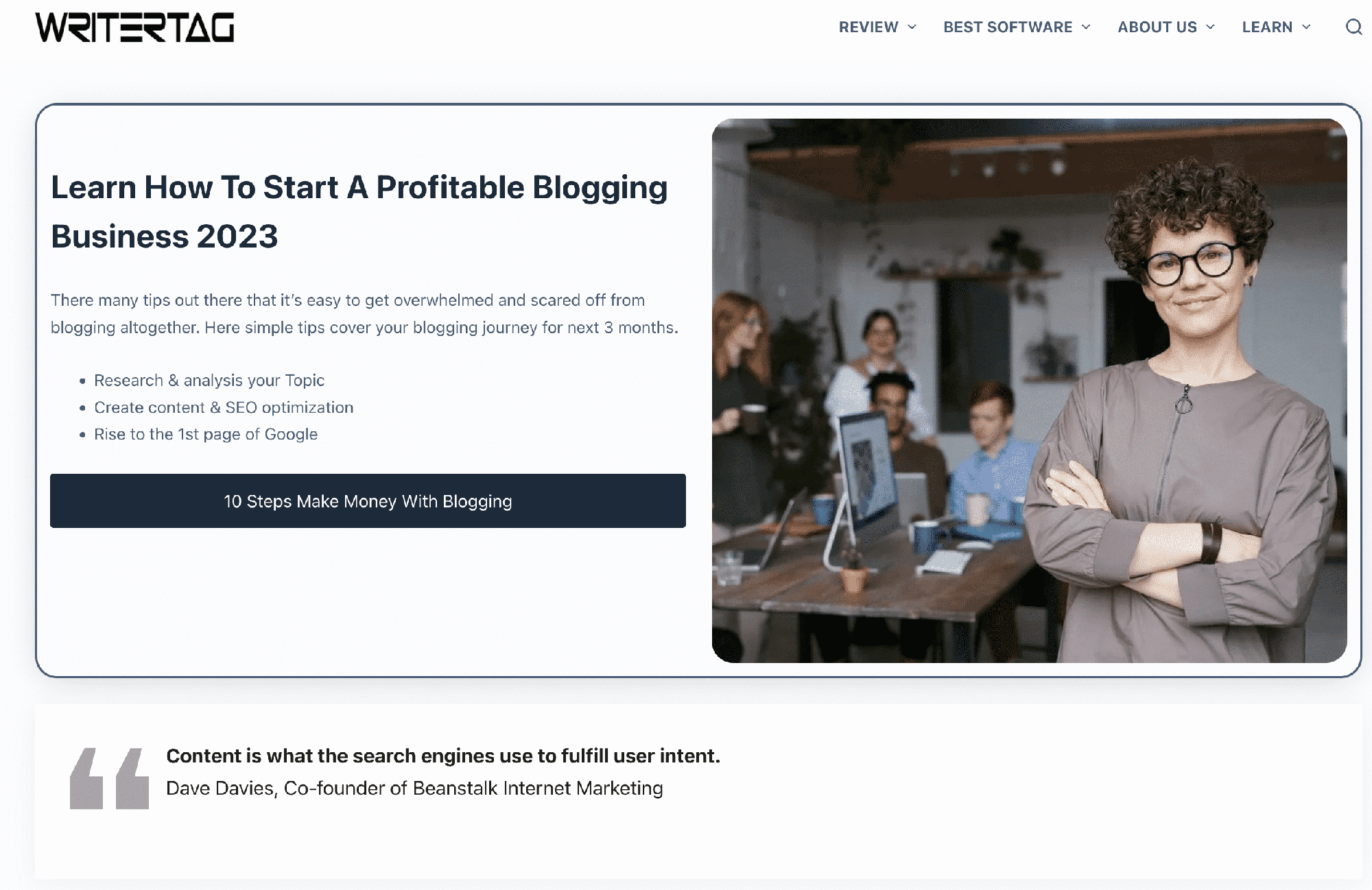In 2025, the digital landscape offers more opportunities and challenges than ever before. Among the smartest moves a blogger can make is to harness the power of rebranding.
Rebranding is not merely changing your blog’s visual aesthetics but a comprehensive approach to redefine your blog’s identity and improve user experience. This strategy can significantly help to boost blog traffic.
Rebranding your blog in 2023 can significantly boost blog traffic by modernizing its look, clarifying its messaging, and aligning it with the audience’s values. It involves steps such as defining a new brand, redesigning the website, realigning content, and announcing the rebrand. A successful rebrand can improve relevance, clarity, and lead to growth.
Key takeaways:
- Rebranding can help your blog stay relevant and competitive.
- It allows you to refocus your blog’s mission and message.
- A successful rebrand can attract new visitors and lead to growth.
- Assess your current brand identity and identify areas for improvement.
- Understand your target audience’s interests and pain points.
- Develop a new brand identity with a new logo, tagline, and website design.
- Launch your rebrand through social media, website updates, and email marketing.
- Consistency is key in building brand recognition and trust.
- Measure the success of your rebrand through increased blog traffic, engagement, and improved SEO performance.
- High-quality content is crucial for a successful blog rebrand strategy.
Why rebranding can boost blog traffic
Rebranding your blog can lead to a surprising surge in traffic. By modernizing your blog’s look and feel, focusing on clearer messaging, and aligning your brand with your audience’s values, you appeal to more visitors, thus leading to higher traffic.
What are the benefits of rebranding?
Here are some important reasons to consider rebranding:
- Relevance: As digital trends evolve, so should your brand. Rebranding helps your blog stay relevant and competitive in your industry.
- Clarity: Rebranding allows you to refocus your blog’s mission and message, providing clarity for your audience.
- Growth: A successful rebrand can attract new visitors and increase engagement, leading to substantial growth.
How to rebrand your blog
Rebranding a blog involves several steps:
- Define your new brand: This includes your blog’s mission, message, and aesthetic. Consider creating a style guide to maintain consistency.
- Redesign your website: Work with a professional designer or use website design tools to revamp your blog’s visual elements.
- Realign content: Make sure all existing content aligns with your new brand message. This may involve updating or removing older posts.
- Announce your rebrand: Launch your new brand with a bang! Communicate the changes to your audience via blog post, email, and social media channels.
One key thing to remember: Rebranding is a thorough and systematic process. It is not just about changing the blog’s design, but about improving the visitors experience holistically.
Step 1: Assess your current brand
Understanding your current brand identity is an essential first step to any successful rebranding strategy. Before jumping into logo redesigns or new marketing messages, you should first take a hard look at what your brand currently does well and where it could be improved.
What is your current brand identity?
Your brand identity is more than just your company name, logo, or slogan. It also involves your values, your product’s unique selling proposition, and the emotions and memories your customers associate with your brand.
Take into consideration:
- How is your brand currently perceived in the market?
- What makes your brand distinct from your competitors?
- What unique selling propositions does your brand offer?
What are your strengths and weaknesses?
Analyzing the strengths, weaknesses, opportunities, and threats associated with your brand (also known as SWOT analysis) can help you identify areas for improvement and potential opportunities you could exploit in your rebranding strategy.
Ask yourself:
- What aspects of your brand identity resonate with your target audience?
- Where is your brand falling short in meeting the expectations of your consumers?
- What negative associations do consumers have with your brand?
What do you want to achieve with your rebrand?
Rebranding is a significant undertaking that requires careful planning and execution. Therefore, a clear understanding of your rebranding goals will guide this strategy and ensure that your efforts are successful.
Some common rebranding objectives you might consider include:
- Improving your brand’s reputation or changing public perception
- Reconnecting with your target audience
- Attracting a new demographic or expanding into new markets
Remember, a successful rebrand is not just about a sleek new logo or an updated website. It requires deep understanding of your existing brand identity, its strengths and weaknesses, and what you wish to achieve with your rebranding efforts. The next step in your rebranding strategy involves developing a plan of action that aligns with these goals.
Step 2: Research your target audience
In order to properly rebrand and boost your blog traffic, it’s imperative to understand who your target audience is. This includes their interests as well as their pain points.
Who are your ideal readers?
The ideal reader of your blog is the person most likely interested in your content. Their demographics, such as age, location, occupation, and hobbies, shape the kind of content you should produce. They form the core base of your readership and are key to growing your blog traffic.
What are their interests?
Understanding the interests of your ideal readers can provide crucial insight on what content will engage them. For example, if your blog is dedicated to technology and gaming, your readers might be interested in reviews, news on game releases, or how-to guides.
What are their pain points?
Identifying your readers’ pain points can significantly help in positioning your blog as a valuable resource. Pain points are problems your readers are trying to solve. Can they find reliable tech product reviews? Are they struggling with the technical aspects of gaming? Your blog content would then aim to address these concerns.
Here’s a simplified table to guide your reader research:
| Questions | Possible Answers |
|---|---|
| Who are your readers? | Tech lovers, gamers |
| Their interests? | Tech product reviews, game releases |
| Their pain points? | Reliability of reviews, tech guides |
This detailed understanding of your audience informs your blogging strategy and allows you to tailor your content to meet their needs and preferences effectively. Ultimately, a blog that regularly provides valuable and appealing content is one that will successfully boost its traffic.
Step 3: Develop a new brand identity
A significant aspect of the rebranding process involves creating a fresh brand identity. This step is your chance to create an impressive and memorable impression on your audience. This includes creating a new logo, developing a meaningful tagline, and designing an appealing website.
Create a new logo and branding guidelines
Creating a new logo is among the initial tasks in establishing a new brand identity. The logo is the visual representation of your brand, and it needs to be unique, appealing, and meaningful. It should be a balance of relevance to your blog niche and attractiveness to your audience.
Simultaneously, developing consistent branding guidelines is key. Branding guidelines lay down the rules for maintaining visual and communicative consistency across all mediums. They account for:
- Use of logo
- Color palette
- Typography
- Imagery style
This consistency helps your brand to establish a strong representation and recall value in the minds of the audience.
Develop a new tagline
A tagline is a concise statement that succinctly encapsulates your brand’s essence. The tagline’s role is to communicate to your target audience what your blog stands for, its core values, or its promise to the readers. The challenge lies in doing this in a catchy, engaging, and memorable way.
Create a new website design
An upgraded website design can drastically improve user experience and engagement, contributing to an increase in blog traffic. The new design should focus on:
- Ease of navigation
- Visual appeal
- Loading speed
- Consistency with brand’s new identity
Implementing these steps effectively can ensure your rebranding exercise resonates with your intended audience, paving the way for a significant boost in blog traffic. Remember to make every element of your new brand identity fully aligned with your blog’s purpose, values, and audience expectations.
Step 4: Launch your rebrand
After all the hard work of planning and preparation, it’s finally time to launch your rebrand! At this stage, every element of your new brand identity should be ready to be revealed and promoted to your blog audience and beyond.
Announce your rebrand on social media
Social media is a powerful tool for spreading the news about your rebrand quickly and efficiently. Be sure to make a significant announcement across all your social media platforms such as Facebook, Twitter, Instagram, and LinkedIn. Consider using captivating graphics or even a short video to convey your new brand message. Remember to be consistent with your new brand identity across all channels.
Update your website and blog
A critical part of launching your rebrand is to update your website and blog to reflect your new brand identity. This includes changes in your logo, color scheme, typography, and even in the tone and style of your content. Ensure that the update is noticeable but remains user-friendly, intuitive, and provides a better browsing experience for your visitors.
Promote your rebrand through email marketing
Lastly, leverage your email marketing strategy to inform your subscribers about the rebranding. This could be in the form of a dedicated email blast or a mention in your regular newsletter. Highlight the reasons behind the rebrand, the new benefits your blog offers, and encourage your subscribers to check out the revamped website and blog.
By following these steps, launching your rebrand can be a seamless process that generates excitement and curiosity around your new brand identity, boosts your blog traffic, and strengthens your online presence.
Conclusion:
In conclusion, 2023 presents an array of game-changing laptops for gaming enthusiasts. Whether it’s the sleek and portable design of the Asus ROG Zephyrus G14, the high-end specs of the MSI GE76 Raider, the durable design of the Lenovo Legion 5 Pro Gen 7, or the slim and sleek design of the Razer Blade Pro 17, there’s something for every gamer. It’s now up to you to decide which features and specifications best suit your needs and budget.
The Importance of Consistency
It is important to be consistent with your brand image and your content’s tone and style. Consistency not only helps in building brand recognition but also fosters trust and loyalty amongst your readers. In the world of blogging, consistency is key for effective SEO and boosting blog traffic.
How to Measure the Success of Your Rebrand
Measuring the success of a rebrand can be somewhat tricky. However, key indicators of success include an increase in blog traffic, user engagement, social shares, and overall improved SEO performance. You can check these stats in your website’s analytics and monitor changes over time.
Remember, rebranding isn’t just about changing your blog’s look – it’s about creating a brand that accurately represents your blog and connects with your target audience. So, review your goals, track your metrics, and remember – consistent, high-quality content is the key to any successful blog rebrand strategy.
In the end, the success of your rebranding efforts should lead to a boost in your blog traffic and engagement rates, and if done strategically, rebranding can be a smart strategy to reenergize your blog and draw in new readers.





